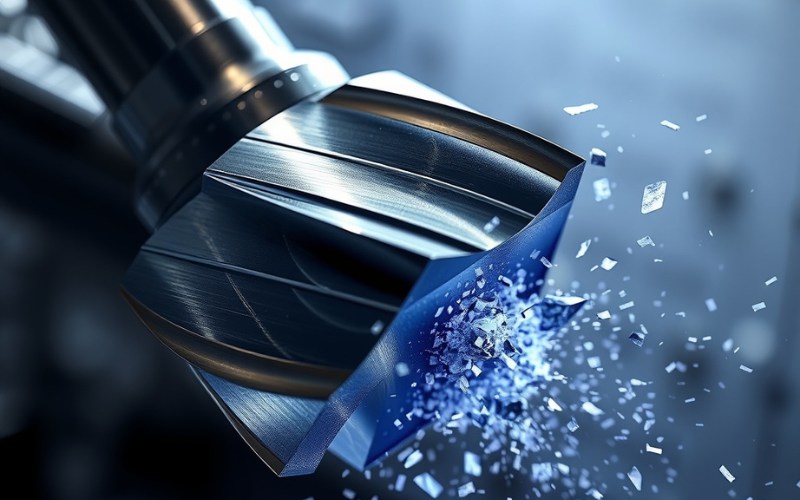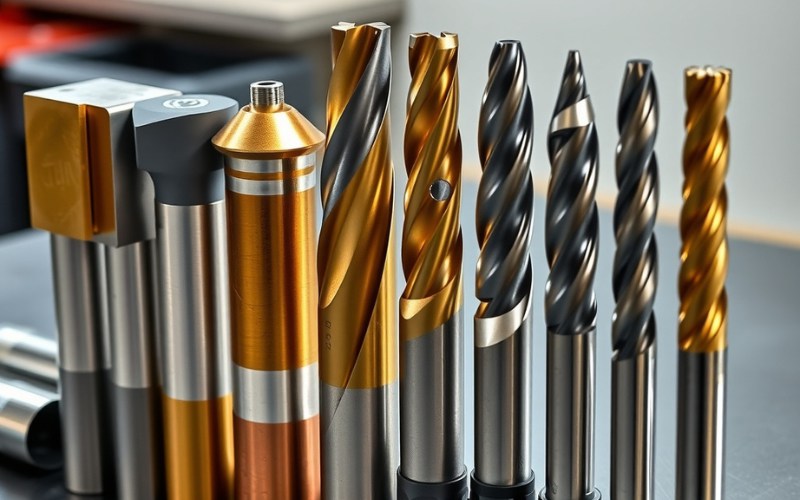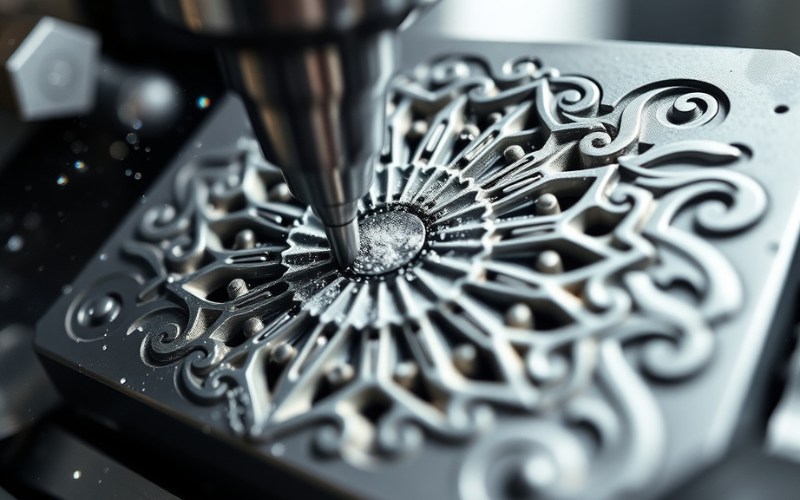Deje que Istar le ayude a poner en marcha su proyecto con nuestra experiencia y conocimientos.
Cargue sus archivos de diseño y requisitos de producción y nos pondremos en contacto con usted en menos de 30 minutos.

An end mill is a very strong tool. In this post, I am going to tell you everything I know about the end milling process. We will talk about what an end mill is. We will also look at the different types of end mills you can buy. And we will learn how to choose the right end mill for your mill machine. If you want to know how this great cutter works on a mill, then this article is for you. I will keep it simple and share what I have learned.
So, what is this tool we call an end mill? To put it simply, an end mill is a type of cutter used in a mill machine. I like to think of it as a drill bit that can do a lot more things. A normal drill bit is made to go straight down into a material to make a round hole. An end mill can do that too. But an end mill is special because it can also cut sideways. This is called peripheral cutting. Because it can cut in many directions, the end mill is very useful in any machine shop. The end mill is a small, strong metal tool. It has sharp edges on its sides and end. These edges are called flutes.
Of course, you cannot use an end mill by itself. You need a machine called a mill, or a milling machine. The end mill goes into a part of the mill called the spindle. The spindle spins the end mill very, very fast. The whole setup, the mill and the end mill, work as a team to cut material very exactly. I have learned that it is very important to have many different end mill cutters. Without the right end mill, your powerful mill is just like a big, heavy rock. The end mill is the star of the show in any milling operation. This little mill cutter is the heart of the mill.

Let’s talk about how the end milling process works. I remember the first time I set up a mill. It looked hard, but the main idea is very simple. First, you take your workpiece, which is a block of metal, plastic, or wood. You fasten it tightly to the table of the mill machine. Then, you choose the right end mill for the job and lock it into the mill’s spindle. This step is very important. A loose end mill is a dangerous end mill. When the end mill is safe in the machine, you can begin.
When you turn on the machine, the end mill starts to spin very fast. This spinning milling cutter is now ready to cut. In many new shops, we use a CNC machine. A CNC machine is a mill that a computer controls. It follows a design on the computer. It moves the end mill or the table in a very exact way. The end mill moves to the piece of material. Its sharp flutes start to cut away the material. This is how milling is used to make all kinds of things. It can make simple cuts or difficult 3D shapes. The end milling process is a basic way of making things. The end mill on the machine does all the shaping. I always like to watch a good end mill work on a good mill.
People often ask me about the difference between end milling and face milling. That is a great question. They are two common ways to do milling. The biggest difference is which part of the cutter does the cutting. It also matters what kind of surface they make. Like I said before, an end mill uses its end and its sides to cut. This makes the end mill perfect for cutting slots, pockets, and the edges of a part. We often call this profile milling. The end milling operation can do many jobs.
A face mill is different. It is a much larger cutter. It is made to cut with the bottom of the tool. A face mill usually has lots of small carbide pieces that do the cutting. You use a face mill to make a large, flat surface on a piece of material. We often call this slab milling. So, you can think of it like this: if you need to cut a deep slot or shape the side of a part, you use an end mill. If you need to make the top of a large block perfectly flat, you use a face mill. I use both kinds of mill cutters. But for work with a lot of detail, the end mill is the tool I choose for the mill. Deciding between an end mill and a face mill depends on what job you need the machine to do.
When we talk about mill types, we are often talking about the different types of end mills. It can feel like a lot when you go to a tool store. There are so many choices. End mills come in many different shapes, sizes, and materials. The two materials you will see most often for an end mill are high speed steel (HSS) and solid carbide. HSS costs less money. It is also a little more forgiving if your machine setup is not perfect. I started by using a high speed steel end mill for most of my work on my first mill.
Carbide end mills are different. They are much harder. They do not wear out as fast. A carbide end mill can cut faster and last longer. This is especially true on tough materials. But, a carbide end mill can also break more easily. So you must be careful with it. Besides the material, the end mill type is also known by its shape. The number of flutes also matters. For example, some end mills are made for rough cutting. Other end mills are made for finishing touches. Picking the right end mill is an important skill. Every end mill has a purpose on the mill. The right end mill tool can save you a lot of time on your machine.
Yes! Let’s take a closer look at the end mills you will use most often. The end mill you pick will make a big difference in how the part turns out. End mills are made for certain jobs. I have used every one of these end mill types on my mill over the years. Here is my easy guide to the main choices for an end mill.
Here is a table to make it easy to understand the different types of end mills:
| End Mill Type | Qué es | My Experience and Best Use |
|---|---|---|
| Square End Mills | These have a sharp corner that makes a perfect 90-degree corner. The end cutting edge is flat. | I use a square end mill for most general milling jobs, like making pockets and cutting slots. This is the end mill I use the most. |
| Ball End Mills | Also known as a ball nose end mill, this mill has a round cutting tip, or a ball end. | The ball end mill is great for making 3D shapes and curves. I use this end mill for milling surfaces with curves. |
| Corner Radius End Mills | This mill is like a square end mill, but the corners are a little bit rounded. | When a part needs a special rounded corner to make it stronger, this is the end mill to use. It is better than a square end mill for helping to stop cracks from forming. |
| Roughing End Mills | These have a special flute design that looks like a corn cob. They are made to remove a lot of material in a short time. | Do not use this end mill for a final cut! I use a roughing end mill to clear out material. Then I change to a finishing end mill. |
| Finishing End Mills | These end mills usually have more flutes. They are made to make the surface very smooth. | After using a roughing end mill, I always change to a finishing end mill for the last cut on the mill machine. |
There are other special end mills too. These include keyway end mills for cutting keyways, a tapered end mill for making cuts at an angle, and corner rounding end mills for making edges round. Each end mill has a job, and the right choice of end mill is very important.
Choosing the right end mill gets easier as you do it more. But I can share some rules that I use. First, think about the material you are cutting. For soft materials like aluminum, I often use a 2-flute or 3-flute end mill. These flute end mills are good at getting rid of the small cut pieces. For harder materials like steel, I use a 4-flute or multi-flute end mill. More flutes can give you a smoother surface. But they can get stuck with material when cutting soft things. The right end mill tool makes the job on the machine easier.
Next, think about the job. Are you doing a rough cut or a finishing cut? As we talked about, there are special roughing and finishing end mills for this. For profile milling, a square end mill o corner radius end mill is a good choice. For making 3D surfaces, you will need a ball end mill o ball nose end mill. Your choice of end mill will change with every new job on the mill. The end mill must be right for the job. This is the most important part of using a mill. Do not be afraid to have many different types of end mills. A good end mill is a good thing to buy.
It may surprise you how many things you see every day are made with an end mill. There are so many uses for end milling. Because it can do so many jobs, end milling is used in almost every type of business. In the car industry, end milling is used to make engine parts. It is also used for molds for car interiors and special parts. The end mill is very important in that area. Companies that build airplanes use CNC milling services a lot. They make very difficult airplane parts that have to be just right. They use end milling to make parts that are light but also very strong. A special end mill is often needed for this.
End milling is even used in medicine. It is used to make special body implants and tools for doctors. I have also seen beautiful art and detailed signs made using an end mill on a CNC machine. The end mill can do it all. It can make simple cuts and keyways. It can also make difficult 3D surfaces. When you need to cut a very exact shape from a solid piece of material, end milling is a great choice. The end mill is a master at making shapes. Every machine shop uses an end mill for something. The end mill is a very busy tool on any mill.

Just like anything, end milling has good parts and bad parts. Let’s look at the advantages and disadvantages of end. The biggest good thing, I think, is that it can do many different jobs. An end mill can make many kinds of shapes and details. This is why milling is a way of machining that so many people use. End mills also allow you to be very exact. With a good mill machine and the correct end mill, you can get a great surface. The size will also be very accurate. The end mill gives you a lot of control.
But, there are some bad things about end milling too. End milling can cost a lot of money. Good quality end mills, especially carbide end mills, cost a lot. The mill machine is also a big purchase. Another problem is that the end mill can get dull. This happens a lot when cutting hard materials. You have to watch your end mill. You have to change it when it is not sharp. A dull end mill will make a poor surface finish. Also, it can be slower at removing material than other ways of cutting. This is especially true for big parts. This is one of the milling and how to overcome challenges we have. We often fix this by using a roughing end mill first. Using an end mill takes some skill.
Every person who uses a machine wants to get a great surface finish. A smooth, clean surface means you did a good job. I have learned a few tricks over the years to get a better surface finish when using my end mill on the mill. First, use a special finishing end mill for your last cut. These end mills are made to leave a nicer finish. A finishing end mill with more flutes often helps. This special end mill type is made for good surface qualities.
Second, think about your speeds and feeds. This means how fast the end mill spins and how fast you move it through the material. Running the mill too fast can leave a rough surface. Sometimes, going slower gives the end mill time to make a cleaner cut. Also, be sure your machine is steady. Your workpiece must be held down very tight. If there is any shaking, you will see it on your final surface. You must also use a good, sharp end mill. A worn end mill will never give you the surface finish you want. The condition of the end mill is very important for the machine. I always check my end mill before a final cut on the mill.
Even after many years, I still think the end mill is a very interesting tool. The idea is simple. It is just a spinning cutter. But it can make things that are very difficult and beautiful. The end mill does most of the hard work on a modern mill machine. Knowing about the different types of end mills is a good skill to have. It will help you, no matter if you do this for a hobby at home or as a job in a big machine shop. I hope this guide helped you learn more about the end mill. The important thing is to start with easy jobs, use the right end mill for the task, and always keep learning. The world of the mill and the end mill is always changing.
Here are the most important things to remember: